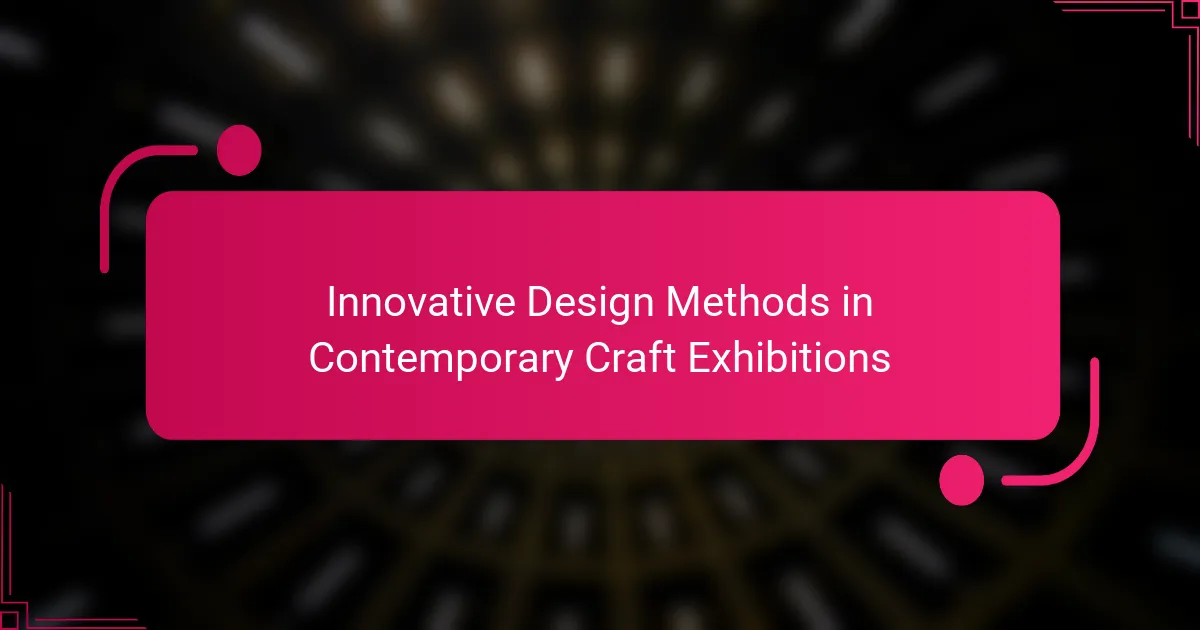Innovative design methods are reshaping contemporary craft exhibitions by enhancing visitor engagement and showcasing creativity. This article explores the integration of interactive technologies, sustainable practices, and collaborative installations. It also examines the challenges curators face in implementing these methods and the importance of audience participation. Finally, it highlights how feedback loops can improve the design process for more immersive experiences.
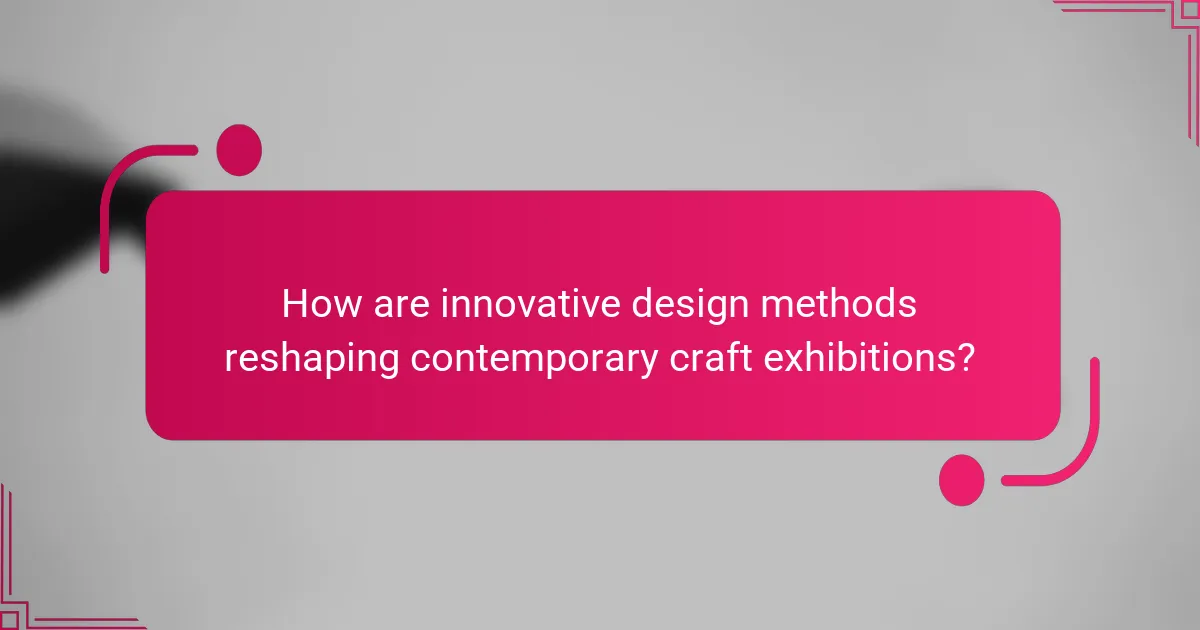
How are innovative design methods reshaping contemporary craft exhibitions?
Innovative design methods are transforming contemporary craft exhibitions by enhancing visitor engagement and showcasing creativity. These methods incorporate interactive elements, digital technologies, and sustainable practices, fostering a dynamic experience. For example, augmented reality allows attendees to visualize the creation process, enriching their understanding of craftsmanship. Additionally, collaborative installations encourage community participation, making exhibitions more inclusive and reflective of diverse perspectives. As a result, these innovative approaches not only elevate the aesthetic appeal but also deepen the narrative behind each craft piece, creating a more immersive experience for visitors.
What are the key characteristics of innovative design methods in craft exhibitions?
Innovative design methods in contemporary craft exhibitions emphasize interactivity, sustainability, and technology integration. These characteristics enhance visitor engagement and create immersive experiences.
Key attributes include the use of augmented reality to showcase craftsmanship, eco-friendly materials that promote sustainability, and participatory installations that invite audience interaction. These methods redefine traditional exhibition spaces and foster a dynamic dialogue between artists and viewers.
The incorporation of digital platforms allows for broader accessibility, enabling remote participation and engagement. This approach not only expands the audience but also enriches the storytelling aspect of craft exhibitions.
As a result, innovative design methods in craft exhibitions are transforming how art is experienced, making it more inclusive and responsive to contemporary societal needs.
Why is audience engagement crucial in contemporary craft exhibitions?
Audience engagement is essential in contemporary craft exhibitions as it fosters connection and interaction. Engaged audiences are more likely to appreciate the artistry and narratives behind the crafts. Innovative design methods enhance this experience by incorporating interactive elements, which can increase visitor participation. For example, workshops and live demonstrations allow attendees to engage directly with the craft process. This engagement not only enriches the visitor experience but also promotes a deeper understanding of the craft’s cultural significance. Ultimately, strong audience engagement can lead to increased attendance and support for future exhibitions.
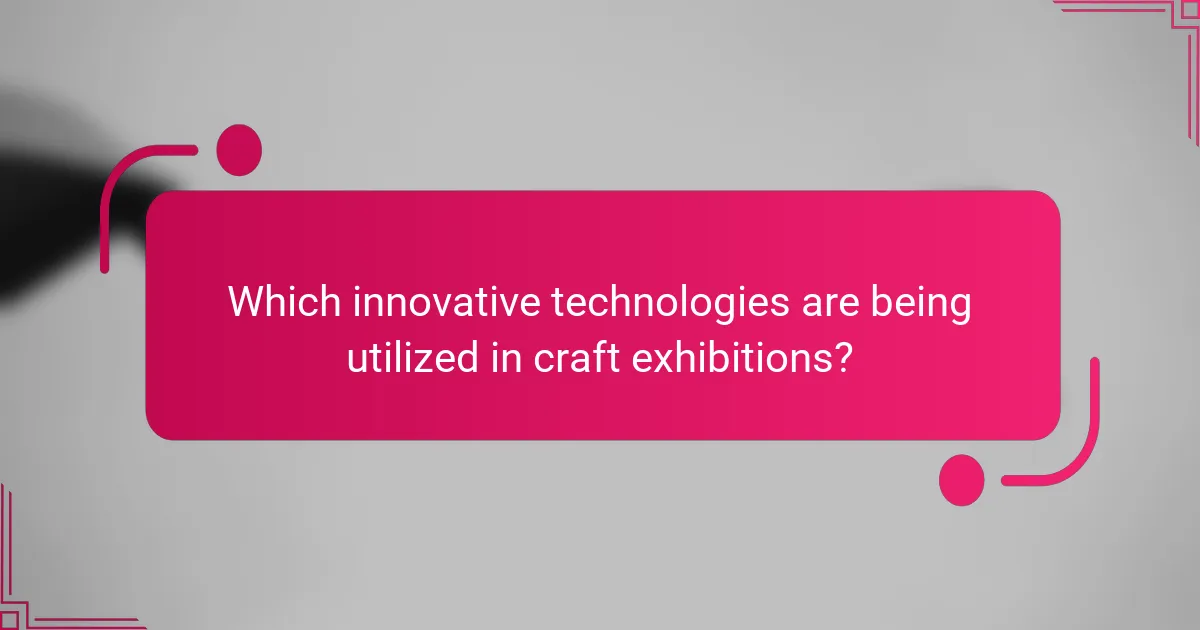
Which innovative technologies are being utilized in craft exhibitions?
Innovative technologies such as augmented reality, 3D printing, and interactive installations are transforming craft exhibitions. These methods enhance visitor engagement and create immersive experiences. For example, augmented reality allows viewers to visualize the crafting process, while 3D printing enables rapid prototyping of unique designs. Interactive installations encourage participation, making exhibitions more dynamic. These technologies showcase the evolving intersection of art and technology in contemporary craft.
How does augmented reality enhance the visitor experience in craft exhibitions?
Augmented reality significantly enhances visitor experiences in craft exhibitions by creating immersive interactions. This technology allows attendees to engage with exhibits in innovative ways, such as visualizing the crafting process or exploring the history of the materials used. For instance, AR can overlay digital information onto physical objects, enriching understanding and appreciation. As a result, visitors experience a deeper connection to the art and craftsmanship, making exhibitions more memorable and educational.
What role does digital fabrication play in contemporary craft design?
Digital fabrication significantly enhances contemporary craft design by enabling precision, customization, and innovation. It allows artisans to merge traditional techniques with modern technology, creating unique pieces that reflect both craftsmanship and advanced manufacturing. For instance, 3D printing and CNC machining facilitate intricate designs that were previously unattainable. This integration fosters collaboration between designers and engineers, expanding the possibilities of material usage and form. As a result, digital fabrication not only streamlines production processes but also enriches the artistic expression within craft exhibitions.
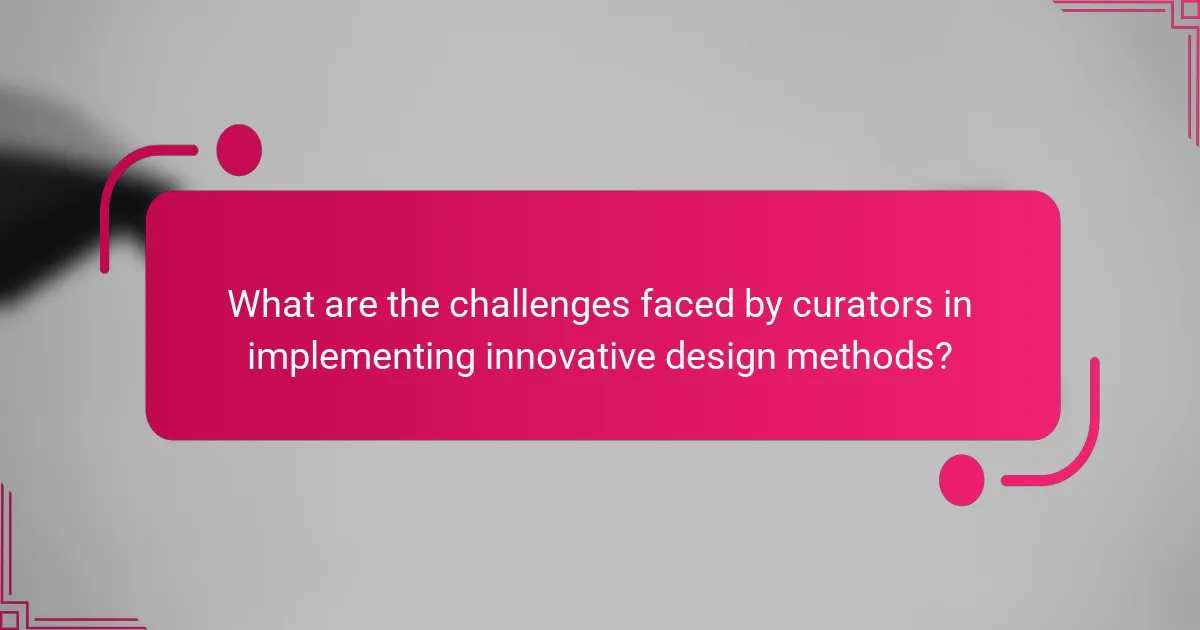
What are the challenges faced by curators in implementing innovative design methods?
Curators face several challenges in implementing innovative design methods in contemporary craft exhibitions. Limited budgets restrict the scope of experimentation. Resistance from traditional stakeholders can hinder the adoption of new approaches. Additionally, balancing artistic vision with audience engagement presents a significant hurdle. Curators must navigate logistical constraints, such as space limitations and installation complexities, which can impact the execution of innovative designs. Lastly, ensuring that new methods resonate with diverse audiences requires careful consideration and research.
How can budget constraints impact the adoption of new design techniques?
Budget constraints can significantly hinder the adoption of innovative design methods in contemporary craft exhibitions. Limited financial resources restrict access to new tools, materials, and training necessary for implementing advanced design techniques. As a result, artists and curators may rely on traditional methods, stifling creativity and innovation. This reliance can lead to less engaging exhibitions that fail to attract diverse audiences. Additionally, budget limitations may prevent collaboration with experts or the integration of cutting-edge technologies that enhance visitor experiences.
What are common logistical hurdles in contemporary craft exhibitions?
Common logistical hurdles in contemporary craft exhibitions include space limitations, budget constraints, and coordination challenges among artists. These factors can hinder the effective display and promotion of innovative design methods. For example, inadequate exhibition space can restrict the variety of works showcased, limiting audience engagement. Budget constraints may force organizers to compromise on quality materials or marketing efforts, impacting overall success. Coordination challenges can arise from managing multiple artists and their schedules, complicating the setup process. Addressing these hurdles is essential for enhancing the exhibition experience and showcasing contemporary craft effectively.
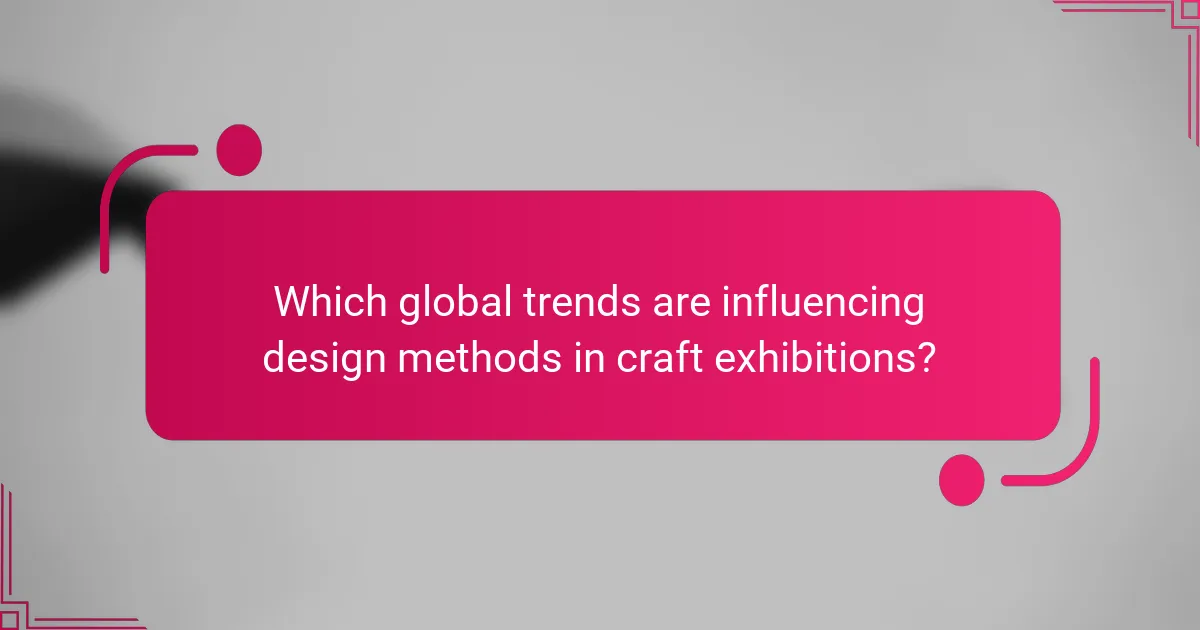
Which global trends are influencing design methods in craft exhibitions?
Innovative design methods in contemporary craft exhibitions are influenced by sustainability, technology integration, and audience engagement. Sustainability drives the use of eco-friendly materials and practices. Technology integration includes virtual reality and interactive displays that enhance viewer experiences. Audience engagement focuses on participatory design, inviting visitors to co-create and influence the exhibition. These trends reflect a shift towards more inclusive and environmentally conscious design approaches in the craft sector.
How do cultural contexts shape the design of craft exhibitions?
Cultural contexts significantly influence the design of craft exhibitions by shaping themes, materials, and audience engagement strategies. Designers often reflect local traditions and contemporary issues, enhancing relevance. For example, exhibitions in Japan may emphasize minimalism and nature, while those in Africa might highlight community and storytelling. This alignment fosters deeper connections between the audience and the craft. Additionally, cultural narratives can dictate the layout and presentation style, ensuring that the exhibition resonates with the intended demographic. Ultimately, understanding cultural contexts leads to innovative, meaningful designs that elevate the craft experience.
What are the emerging themes in contemporary craft that drive innovation?
Emerging themes in contemporary craft driving innovation include sustainability, technology integration, and cultural storytelling. These themes reflect a shift towards environmentally conscious practices, the use of digital tools, and the exploration of identity through craft. Sustainability emphasizes eco-friendly materials and processes, while technology integration enhances design capabilities. Cultural storytelling allows artisans to convey personal and communal narratives through their work.
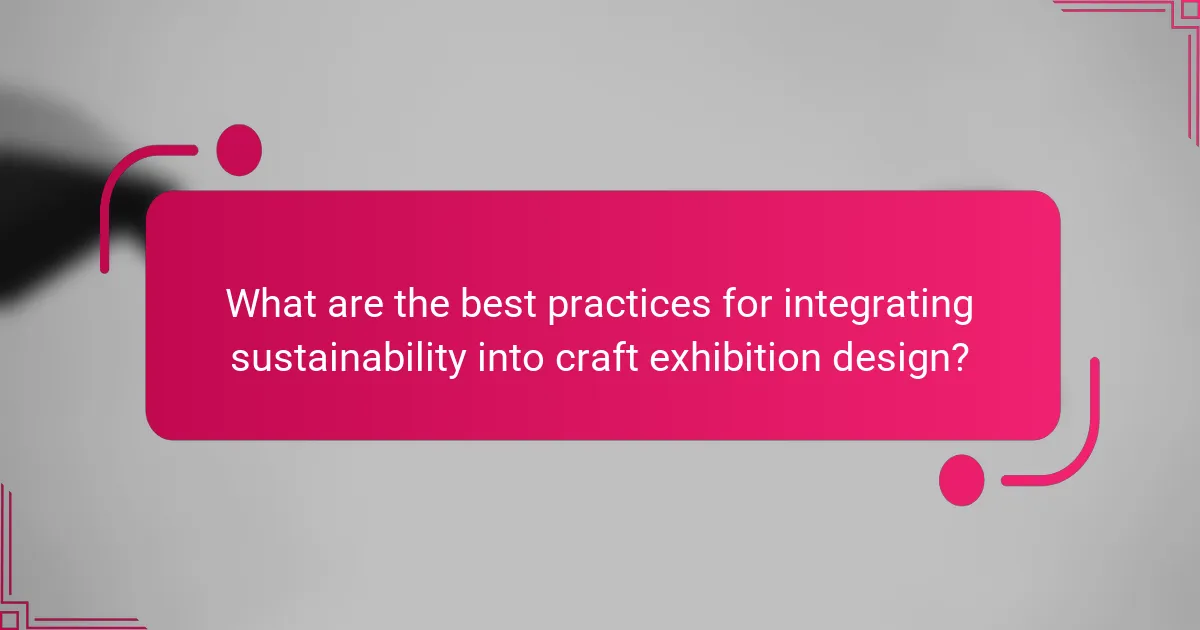
What are the best practices for integrating sustainability into craft exhibition design?
Integrating sustainability into craft exhibition design involves using eco-friendly materials, optimizing space, and minimizing waste. Prioritize natural lighting to reduce energy consumption.
Utilize modular displays to adapt to various venues, enhancing resource efficiency. Engage local artisans to promote community and reduce transportation emissions.
Incorporate digital elements to replace physical materials, showcasing work while minimizing environmental impact. Evaluate the lifecycle of materials used, selecting those that are recyclable or biodegradable.
Encourage visitor participation through workshops that highlight sustainable practices in craft. This approach fosters awareness and inspires future sustainable initiatives in design.
How can materials selection impact the ecological footprint of exhibitions?
Material selection significantly influences the ecological footprint of exhibitions. Sustainable materials reduce waste and energy consumption, promoting environmental responsibility. For instance, using recycled or locally sourced materials minimizes transport emissions and resource depletion. Innovative design methods can further enhance this impact by integrating modular designs, which allow for reusability and adaptability. Consequently, exhibitions can achieve aesthetic goals while maintaining ecological integrity, ultimately fostering a culture of sustainability in contemporary craft.
What strategies can be employed to promote sustainable practices among exhibitors?
To promote sustainable practices among exhibitors, implement strategies that encourage eco-friendly designs and materials. Foster collaboration with local artisans to highlight sustainable craftsmanship.
1. Educate exhibitors on sustainable materials and methods.
2. Provide incentives for using eco-friendly practices.
3. Organize workshops on innovative sustainable design.
4. Showcase successful sustainable exhibitions as case studies.
5. Create a certification program for sustainable practices.
6. Utilize digital platforms to reduce physical resource consumption.
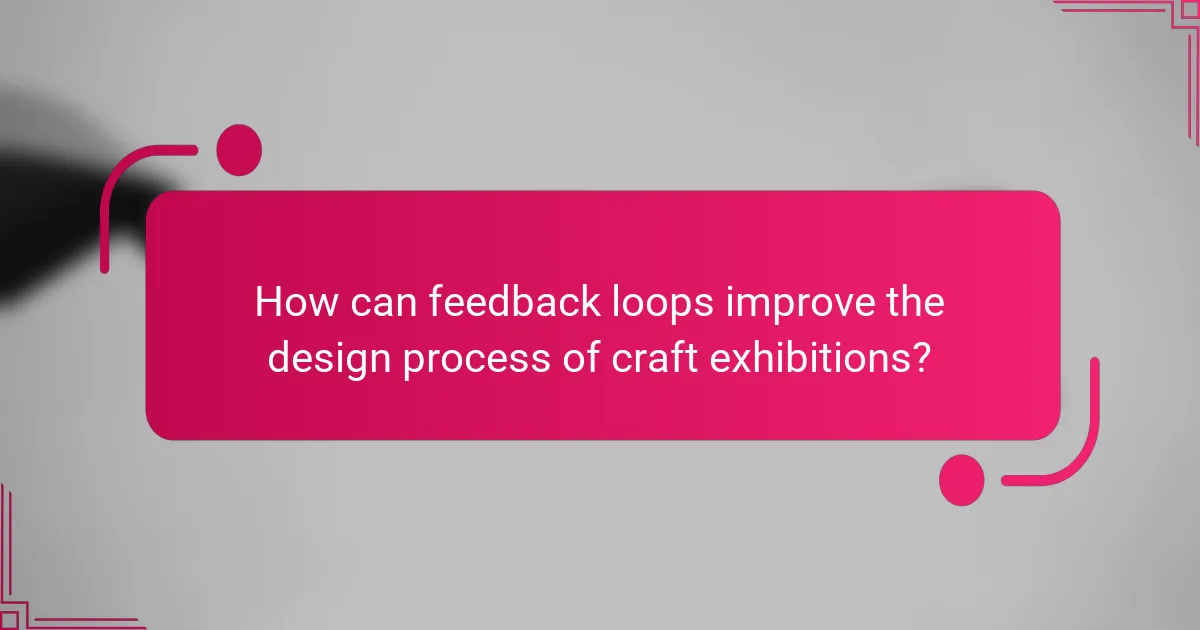
How can feedback loops improve the design process of craft exhibitions?
Feedback loops significantly enhance the design process of craft exhibitions by facilitating continuous improvement. They allow designers to gather insights from audiences, leading to more engaging and relevant displays. For example, iterative feedback helps identify visitor preferences, which can be integrated into future designs. This adaptive approach fosters innovation and responsiveness, ultimately enriching the exhibition experience.
What methods can be used to gather visitor feedback effectively?
To gather visitor feedback effectively, employ interactive methods that engage participants. Techniques include digital surveys, comment walls, and in-person interviews. These methods encourage honest responses and provide actionable insights for improving exhibitions. Engaging visitors through innovative feedback channels enhances the overall experience and fosters community involvement.
How can iterative design enhance future craft exhibitions?
Iterative design enhances future craft exhibitions by fostering continuous improvement and innovation. This approach allows designers to refine their concepts based on feedback, ensuring that each exhibition better meets audience expectations. Engaging visitors in the design process creates a more dynamic and interactive experience. Additionally, iterative design encourages experimentation with materials and techniques, leading to unique and diverse displays that captivate attendees. This method ultimately results in exhibitions that are not only visually appealing but also resonate more deeply with the audience.
What expert tips can help curators optimize innovative design methods in craft exhibitions?
Curators can optimize innovative design methods in craft exhibitions by embracing collaboration, utilizing technology, and focusing on user experience. Collaborating with artists and designers fosters creativity and diverse perspectives. Integrating technology, such as augmented reality, enhances visitor engagement and interaction. Prioritizing user experience through thoughtful layout and accessibility ensures that exhibitions resonate with audiences.
